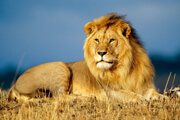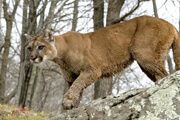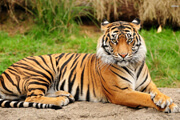Lions and tigers and bears… well, just lions for now!
Physical Characteristics
Lions, one of the four big cats, are the second-largest living cat after the tiger. In the wild, they tend to live relatively short lives: males may reach 12-14 years before natural death occurs, while female lionesses will often only live until 8 years of age. Many lions and lionesses in captivity have been known to live a full, long life of 20 years or more. Visually, male lions are highly distinctive and recognized by their large, bushy manes. Of course, the head of a male lion, mane and all, is one of the most highly recognized animal symbols in human culture – just think of that roaring lion head that appears after many of your favourite movies and TV shows!
 Lions are known for their beautiful manes
Lions are known for their beautiful manes
Lions are the tallest (shoulder-height) of all the felines, and the second-heaviest after the tiger. Lions can weigh between 350-550 pounds for males and 260-400 pounds for females. Powerful legs, strong jaws and long, canine teeth (8 cm long!) all help the lion bring down some pretty powerful prey. Lion coloration ranges from light buff to yellowish or reddish brown, with lighter underparts and a black tuft at the end of the powerful tail. Lion cubs are actually born with spots on their bodies, like those of a leopard or jaguar, but these fade as the cubs grow into adulthood.
The mane of the male lion, unique among cats (along with the tufted tail) plays a very specific role in the survival of the species. It makes the lion look larger and more intimidating to other animals and competitors. The mane also keeps the lion warm during winter.
Hunting Habits
Hunting in a lion pride is usually done by the females, since they are smaller and more agile than the males. Lions prefer large mammals, especially wildebeest, impalas, zebras, buffalo and warthogs in Africa.
Groups of lionesses typically hunt together for large prey. They hunt with pride and catch their prey with precise and complex teamwork. In fact, each lioness develops specific skills for her role in the hunting techniques used by her pride and, generally, assumes that role during most hunts.
Adult lions have zero natural predators, but the majority die violently because of humans or other lions. Because male lions fiercely defend their prides, they often come into aggressive contact with other males. .
Home and Habitat
Currently, wild lions live in Sub-Saharan Africa and Asia. The population of lions in India is very small and extremely endangered. At one point, lions could be found roaming across North Africa, the Middle East and Western Asia, but have long since disappeared from these parts of the world.
Lions typically inhabit savannah and grassland, though they will make bush and forest areas their home, too.
Social Studies
Compared to other big cats, like the solitary leopard or jaguar, lions are relatively social felines. They live in groups called prides, which consist of related females and offspring and a small number of males.
Some lions – called nomads – constantly move around individually or in pairs, rather than live in a pride. These types of lions may actually have been rejected or excluded from their birth pride, as prides typically only accept a maximum of two males. If these nomad lions can find a pride to join, then they can alter their lifestyle.
When cubs are first introduced to a pride, they’re usually quite shy and lack confidence when the other adult lions (other than their mother) confront them. But cubs soon get used to pride life, playing with their siblings and often trying to initiate games with the adults.
Lions in a pride love to communicate with each other. If you ever get the chance to observe a pride of lions, you may see them rubbing their heads together, nuzzling and licking each other. Lions also have quite a few facial expressions and can make a range of sounds: snarling, purring, hissing, coughing, meowing, woofing and, of course, roaring. A lion’s roar can be heard from a distance of 5 miles away.
Conservation Status
Lion numbers are decreasing quickly, mainly due to loss of habitat and human beings.

































